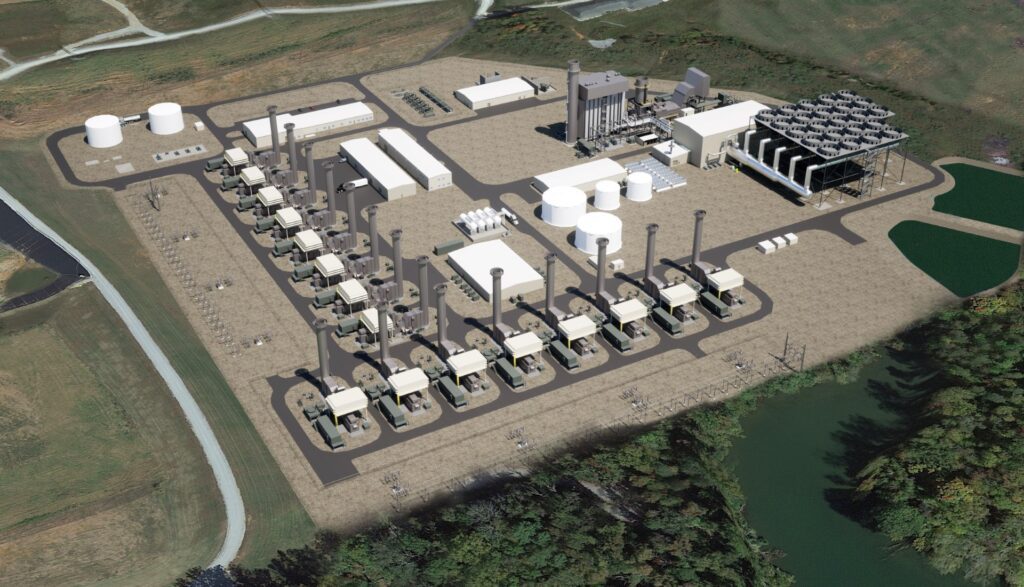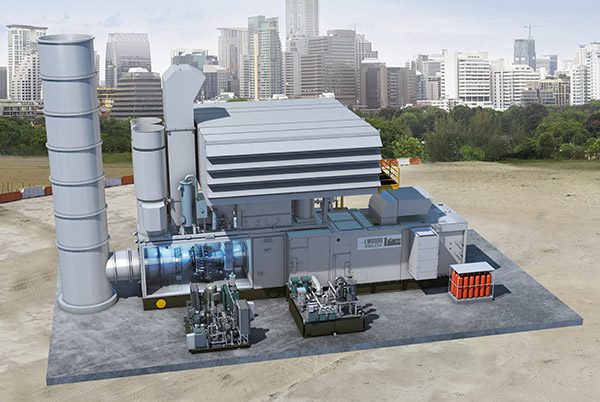TVA Secures 16 GE Vernova Aeroderivative Gas Turbine Packages for Kingston Replacement
GE Vernova has bagged the Tennessee Valley Authority’s (TVA’s) first order as part of a fast-track project to replace the 1.3-GW Kingston Fossil Plant in Tennessee with a 1.5-GW modern complex.
The original equipment manufacturer will supply 16 aeroderivative LM6000VELOX dual fuel DLE (dry low emissions) gas turbine and generator packages, which are expected to deliver 850 MW when they begin operating in 2028. The new plant will “provide more flexible, reliable and dispatchable generation to support the growth in intermittent renewables,” GE Vernova said.
Multi-Source Replacement for Aging Kingston Coal Plant
The order marks an important first step for TVA, which announced in April that it would retire the nine-unit coal facility in Roane County. In a record of decision (ROD), TVA said the “need for [Kingston] to operate at full capacity has decreased” given the evolution of its generating fleet over the past 10 to 15 years—primarily driven by additions of nuclear, gas, and renewable resources. TVA noted it had resorted to more frequent cycling of Kingston’s units to meet fluctuating loads.
In its ROD, the TVA highlighted plans to replace the coal plant’s decades-long workhouse capacity with a natural gas-fired CCGT combined with 16 dual-fueled aero-derivative combustion turbines, a 3 MW to 4 MW solar site, a 100-MW battery storage site, along with a new 161-kV switchyard on the Kingston Reservation.
While the ROD kicked off the technology selection and procurement process, it also underscored the urgency for a quick replacement, noting that the replacement generation “must continue to maintain the planning reserve margins and to provide transmission system voltage support to the local area that is needed to maintain overall system stability and reliability.” So far, no decisions have been made beyond the aeroderivative units announced on Monday, the TVA confirmed.
“The Kingston Energy Complex highlights the way diverse generation works together to ensure TVA can provide more reliable, resilient, and affordable power,” said TVA Chief Operating Officer Don Moul on Monday. “These aeroderivative units will help us meet demand during peak energy usage and supplement solar generation on days when sunshine is limited.”

Traction for GE Vernova’s LM6000VELOX Package
The order also indicates continued commercial uptake of GE Vernova’s LM6000VELOX packages, which the company introduced in October 2023. The first 10-unit package is set to be introduced at TVA’s Johnsonville Aeroderivative Plant in Middle Tennessee, marking a first for TVA’s fleet of natural gas plants.
At the core of the package is the LM6000, a 44.7-MW to 56-MW aeroderivative gas turbine launched in 1988, derived from GE’s CF6-80C2 high bypass turbofan aircraft engine. More than 1,200 LM6000 gas turbines have since been installed across 60 countries, GE Vernova said. “These units are well-known in the power generation industry for their quick start time of down to 5 minutes to full power, high cyclic life helping to complement intermittent power from renewable sources, and operational flexibility which can help stabilize the grid and reduce the risk of electricity supply shortages,” the company explained.
The LM6000 offers “greater than 99% start and operational reliability and over 98% availability,” it noted. “In addition, the turbine in a Singular Annular Combustor (SAC) configuration has the capability to burn up to 100% hydrogen by volume, which can reduce or eliminate CO2 emissions from power delivered by a gas turbine.”
The concept of packaging the LM6000 stems from an initiative to reduce the installation and commissioning schedule of LM6000 turbines by up to 40%, saving up to 4,000 labor hours.” According to GE Vernova, the initiative speaks to inherent benefits presented by aeroderivatives to support the massive buildout of renewables. Compared to other available gas turbine models, aeroderivatives feature faster start-up time and higher simple cycle efficiency. Aeroderivatives are also relatively compact and lightweight, facilitating easier transportation and installation. Compact modular packaging enables quick installation and deployment, it noted.
GE Vernova has long offered a package for its LM2500 aeroderivative gas turbine technology (with a capacity range of 33 MW to 36.3 MW). GE Vernova’s LM2500XPRESS power plant, launched in January 2020, is 95% factory-assembled “into simplified modules for quick and easy site installation. Where power is needed quickly, the plant can be installed in as little as two weeks with a relatively small crew,” it noted.
The 57-MW LM6000VELOX package follows up on the LM2500XPRESS’s success, GE Vernova said. At TVA, the 16 LM6000VELOX packages also feature a dual-fuel capability, allowing them to operate flexibly on natural gas or liquid fuels if needed. “In addition, the DLE combustor configuration is capable of meeting stringent environmental regulations, meeting emissions limits that comply with the regional air district requirements, and avoiding water consumption for NOx emissions abatement,” it said.

A Growing Market for Aeroderivatives
The market for aeroderivatives is growing in the power generation and energy-intensive industries, GE Vernova noted. The company points to industry forecasts, which suggest North America and Europe will continue to lead the demand for aeroderivative gas turbines. “This is due to well-established power generation infrastructures, stringent emissions regulations, and strong commitment to renewable energy,” it notes.
The company suggested that Europe is already fielding a demand for reserve and peaking power solutions. RWE Generation recently installed 11 “plug and play” LM2500XPRESS units to provide a critical gas-power reserve in Germany’s reliability-challenged southern region. Similarly, the Swiss Federal Office of Energy’s 250-MW station at Birr utilizes eight TM2500 mobile gensets. In Ireland, the Electricity Supply Board has enhanced its reserve power capabilities with installations at Shannonbridge and Northwall, each equipped with six LM2500XPRESS units and a 150-MW plant at Tarbert powered by three LM6000 units.
However, other global regions are also looking intently at aero derivatives as a solution to support their sustainable energy transitions and reduce environmental impacts. Taiwan Power Co. has so far integrated six LM2500XPRESS units to provide an additional 175 MW of capacity, facilitating a coal-to-gas energy shift and supporting the integration of wind power. In Yemen, PetroMasila embarked on a transition from diesel to natural gas power using GE Vernova’s TM2500 units.
Hydrogen readiness is also bolstering prospects for aeroderivatives. As POWER reported in detail in 2022, the LM6000 turbine showcased that capability at the New York Power Authority’s Brentwood Power Station, achieving operation with up to 44% hydrogen—some of the highest volumes of hydrogen blended into a commercially operating gas turbine.
Similarly, Australia’s CS Energy is pioneering Queensland’s first hydrogen-ready facility at its Brigalow Peaking Power Plant. In January 2024, GE Vernova said the 400-MW project would utilize 12 LM2500XPRESS aero-derivative gas turbines in the new power station. Once operational in 2026, Brigalow will be capable of operating initially on 35% (by volume) of renewable hydrogen, with a pathway to 100 percent hydrogen over this decade.
—Sonal Patel is a POWER senior editor (@sonalcpatel, @POWERmagazine).